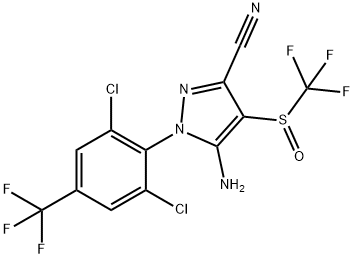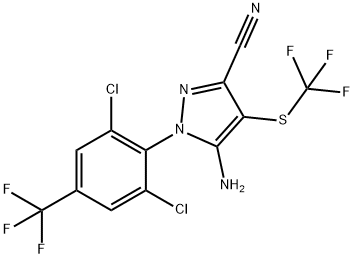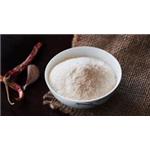Fipronil is a white powder with a mouldy odour. It has a low solubility in water and is a
slow-acting poison. It does not bind strongly with soil, and the half-life of fipronil– sulphone
is 34 days. Fipronil is a broadspectrum insecticide of the phenylpyrazole group. Fipronil
was first used extensively for the control of ants, beetles, cockroaches, fleas; ticks, termites,
mole crickets, thrips, rootworms, weevils, flea of pets, field pest of corn, golf courses, and
commercial turf, and other insects. Fipronil was first used in the United States in 1996.
Fipronil is a topical insecticide. It kills adult fleas and larvae, ticks, and chewing lice. As a
liquid, fipronil is applied on the back side skin of dogs and cats. Reports indicate that some
animals do become hypersensitive (allergic) to fipronil.
A broad spectrum insecticide which actively disrupts the CNS of contacted insects by blocking the passage of chloride ions through GABA receptors.
Fipronil is used for the control of a wide range of insect species in
rice, cereals, corn, cotton, top fruit, sugar beet, sugar cane, oilseed rape,
many vegetables and other high-value crops. It also has a veterinary use
as an ectoparasiticide.
ChEBI: 5-amino-1-[2,6-dichloro-4-(trifluoromethyl)phenyl]-4-[(trifluoromethyl)sulfinyl]-1H-pyrazole-3-carbonitrile is a member of the class of pyrazoles that is 1H-pyrazole that is substituted at positions 1, 3, 4, and 5 by 2,6-dichloro-4-(trifluoromethyl)phenyl, cyano, (trifluoromethyl)sulfinyl, and amino groups, respectively. It is a nitrile, a dichlorobenzene, a primary amino compound, a member of pyrazoles, a sulfoxide and a member of (trifluoromethyl)benzenes.
Insecticide, Veterinary medicine: Not approved for use in EU countries. Fipronil
was introduced into the U.S. in 1996 for use in animal
health and indoor pest control. It is the constituent of many
products for controlling a wide spectrum of domestic animal and residential pests.
BES® 602; CEASEFIRE®; CHIPCO®;
COMBAT®; FRONTLINE; MB-46030®; H&G®;
ICON®; MAXFORCE® ANT STATION; MAXFORCE®
ROACH STATION; REGENCY SOFION®; REGENT®;
REGENT® 500-FS; TERMIDOR® L VI-NIL
Fipronil is a phenylpyrazole, the mode of action of which
is to inhibit nerve transmission in arthropods by blocking
γ -aminobutyric acid-gated chloride channels. Fipronil is
available as spray and spot-on formulations to control
fleas and ticks on cats and dogs. The adulticidal activity of
fipronil accounts for the majority of its activity, although
additional activity against flea eggs and larvae results
from the presence of fipronil on hairs and debris shed into
the environment from treated pets.
Autohistoradiography studies (11) into the cutaneous
distribution of 14C-fipronil in the cat and dog following
spot-on administration demonstrated that radioactivity
was restricted principally to the stratum corneum, the
viable epidermis, and the pilosebaceous units. Following
its slow release from sebaceous glands, fipronil migrates in
the sebum covering the skin and hairs by passive diffusion
and was shown to persist on hair for up to 2 months after
treatment.
Example 1: This example illustrates the synthesis of 5-amino-1-(2,6-dichloro-4-(trifluoromethyl)phenyl)-4-((trifluoromethyl)sulfinyl)-1H-pyrazole-3-carbonitrile. 100 g (0.23 mol) of 5-amino-3-cyano-1-(2,6-dichloro-4-trifluoromethylphenyl)-4-trifluoromethylthiopyrazole (compound of formula (II)) was dissolved in a solvent mixture consisting of 900 g (6.97 mol) of dichloroacetic acid (DCAA) and 30 g (0.3 mol) of concentrated sulfuric acid. After stirring at 15°C for 30 min, 25 g (0.22 mol) of 30% w/w aqueous hydrogen peroxide solution was slowly added over 90 min. The reaction was continued until HPLC analysis showed a conversion of more than 95%. Upon completion of the reaction, the reaction mixture was quenched using sodium sulfite (Na2SO3). Subsequently, the separation and purification of the product was carried out by conventional methods, resulting in the target product in 98% yield and 97.5% HPLC purity.
Pyrazole/phenylpyrazole/organofluor ine insecticide; veterinary medicine. Fipronil was intro duced into the United States in 1996 for use in animal
health and indoor pest control. It is the constituent of many
products for controlling a wide spectrum of domestic ani mal and residential pests. Banned for use in EU.
Through the abiotic degradation of fipronil in aqueous
solution and on the soil surface, 5-amino-3-
carbamoyl-1-[2,6-dichloro-4-(trifluoromethyl)-phenyl]-4-
[(trifluoromethyl)sulfinyl]pyrazole is the only hydrolysis
product detected. Fipronil in acidic aqueous solution
exposed under a xenon lamp degrades with the
concomitant appearance of 5-amino-3-cyano-1-[2,6-
dichloro-4-(trifluoromethyl)-phenyl]-4-
(trifluoromethyl)pyrazole and 5-amino-3-cyano-1-[2,6-
dichloro-4-(trifluoromethyl)phenyl]pyrazole-4-sulfonic
acid. Under field conditions, when fipronil is applied in
formulation, four metabolites which include one
product resulting from reduction on the sulfur atom of
fipronil are detected.
UN2588 Pesticides, solid, toxic, Hazard Class:
6.1; Labels: 6.1-Poisonous materials, Technical Name
Required. UN2902 Pesticide, liquid, toxic, n.o.s., Hazard
Class: 6.1; Labels: 6.1-Poisonous materials, Technical
Name Required.
Fipronil is stable in water at pH 5 and 7 but is slowly hydrolysed at pH 9
(DT50 28 days) to the amide (2). It undergoes rapid aqueous photolysis
with a DT50 of ﹤0.5 day. The major photodecomposition product in water
and on soil surfaces is desulfinyl-fipronil(3) which is formed by extrusion
of the SO group. A minor photoproduct in water, on soil and on plant
surfaces is the sulfonic acid (4). The mechanisms of these reactions are
discussed in a recent paper by Bobe et al. (1998).
Acute oral LD50 for rats: 100 mg/kg
It is the responsibility of
chemical waste generators to determine the toxicity and
physical properties and of a discarded chemical and to
properly identify its classification and certification as a haz ardous waste and to determine the disposal method. United
States Environmental Protection Agency guidelines for the
classification determination are listed in 40 CFR Parts
261.3. Additionally, waste generators must consult and fol low all regional, national, state and local hazardous waste
laws to ensure complete and accurate classification and dis posal methods.
[1] Patent: WO2012/7938, 2012, A1. Location in patent: Page/Page column 9-10
[2] Patent: WO2007/122440, 2007, A1. Location in patent: Page/Page column 10-11
[3] Patent: US2009/30211, 2009, A1. Location in patent: Page/Page column 3
[4] Patent: WO2007/122440, 2007, A1. Location in patent: Page/Page column 11
[5] Patent: US2009/30211, 2009, A1. Location in patent: Page/Page column 3




